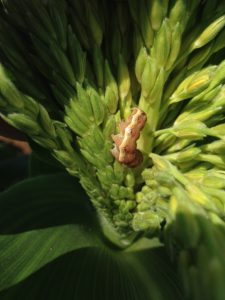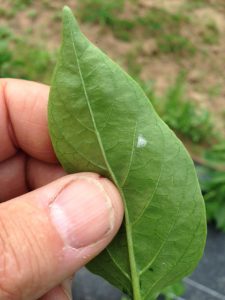Sweet Corn
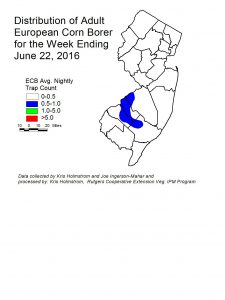 European corn borer (ECB) moth catches are very low now. The first flight is largely over, and as is common, feeding signs in the field have increased as eggs hatch. Present adult activity is largely confined to Gloucester and parts of surrounding counties (see ECB map). Larval feeding ranges from single digits to 40% in areas where IPM personnel are operating, although many plantings still have no detectable feeding at all. The highest feeding percentages are currently in Mercer and parts of Morris counties. Be sure to begin monitoring plantings for ECB feeding while they are still in the whorl stage. Consider treating when the number of infested plants in a 50 plant sample exceeds 12%. Feeding in the whorl stage will appear as numerous small holes (called “shot-hole”) on leaves, with damage present on consecutively younger leaves. As plants progress to pre-tassel and beyond, droppings and larvae may be found in or on the emerging tassels (see
European corn borer (ECB) moth catches are very low now. The first flight is largely over, and as is common, feeding signs in the field have increased as eggs hatch. Present adult activity is largely confined to Gloucester and parts of surrounding counties (see ECB map). Larval feeding ranges from single digits to 40% in areas where IPM personnel are operating, although many plantings still have no detectable feeding at all. The highest feeding percentages are currently in Mercer and parts of Morris counties. Be sure to begin monitoring plantings for ECB feeding while they are still in the whorl stage. Consider treating when the number of infested plants in a 50 plant sample exceeds 12%. Feeding in the whorl stage will appear as numerous small holes (called “shot-hole”) on leaves, with damage present on consecutively younger leaves. As plants progress to pre-tassel and beyond, droppings and larvae may be found in or on the emerging tassels (see 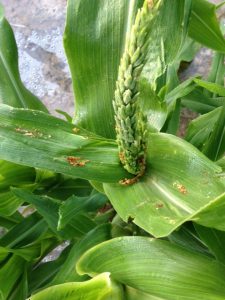 photo at right). Any planting remaining at or above threshold as it proceeds to full tassel should be treated, as this is the last stage at which ECB larvae will be exposed and vulnerable to insecticidal sprays. Insecticides that are acceptable in organic production include the spinosyn based material Entrust (IRAC-5) and Dipel (IRAC-11a). The 10G formulation of Dipel is particularly useful when granules can be dropped or broadcast such that they get into the whorls of corn plants. Other effective insecticides include Coragen (IRAC 28), and the synthetic pyrethroids (IRAC 3). See the 2016 Commercial Vegetable Recommendations Guide for a more complete list of insecticides.
photo at right). Any planting remaining at or above threshold as it proceeds to full tassel should be treated, as this is the last stage at which ECB larvae will be exposed and vulnerable to insecticidal sprays. Insecticides that are acceptable in organic production include the spinosyn based material Entrust (IRAC-5) and Dipel (IRAC-11a). The 10G formulation of Dipel is particularly useful when granules can be dropped or broadcast such that they get into the whorls of corn plants. Other effective insecticides include Coragen (IRAC 28), and the synthetic pyrethroids (IRAC 3). See the 2016 Commercial Vegetable Recommendations Guide for a more complete list of insecticides.
The highest nightly ECB catches for the previous week are as follows:
| Cinnaminson 2 | Farmingdale 1 | Lawrenceville 1 |
| Denville 1 | Folsom 1 | Medford 1 |
| Downer 1 | Georgetown 1 | New Egypt 1 |
| Elm 1 | Green Creek 1 | Pennington 1 |
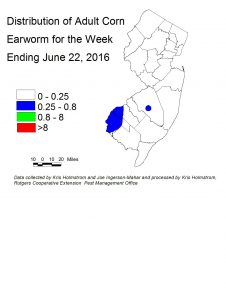 Corn earworm moth (CEW) captures in blacklights have been very low this past week. It is likely that we are entering a period of very few adults. Generally this occurs from late June through the first half of July. Present adult activity recorded in blacklights is primarily near the Delaware Bayshore (see CEW map at left). The low population of CEW adults that we had for the previous several weeks resulted in egg laying in tassels. This occurs when there are no silks yet present for the
Corn earworm moth (CEW) captures in blacklights have been very low this past week. It is likely that we are entering a period of very few adults. Generally this occurs from late June through the first half of July. Present adult activity recorded in blacklights is primarily near the Delaware Bayshore (see CEW map at left). The low population of CEW adults that we had for the previous several weeks resulted in egg laying in tassels. This occurs when there are no silks yet present for the
female moths. CEW larval feeding in tassels (see photo at right) is not typically injurious to developing ears and is not counted in feeding percentages as with ECB and fall armyworm.
The highest nightly CEW catches for the previous week are as follows:
| Denville 1 | Folsom 1 |
| East Vineland 1 | Pedricktown 1 |
| Elm 1 | Tabernacle 1 |
 In addition, a limited number of CEW pheromone traps have been deployed throughout the southern counties. These traps have captured low numbers of CEW moths (see CEW pheromone map). The broad color patterns of this map are a result of the few numbers of contributing trap sites. As sweet corn plantings begin to silk, it is critical that growers monitor local CEW moth numbers. For the present time, any sweet corn plantings in the silk stage should be treated to limit CEW injury as well as to prevent ear damage from ECB larvae that already inhabit the stalks.
In addition, a limited number of CEW pheromone traps have been deployed throughout the southern counties. These traps have captured low numbers of CEW moths (see CEW pheromone map). The broad color patterns of this map are a result of the few numbers of contributing trap sites. As sweet corn plantings begin to silk, it is critical that growers monitor local CEW moth numbers. For the present time, any sweet corn plantings in the silk stage should be treated to limit CEW injury as well as to prevent ear damage from ECB larvae that already inhabit the stalks.
The highest nightly CEW pheromone trap catches for the previous week are as follows:
| Monroeville 15 | Pedricktown 9 |
| Woodstown 11 | East Vineland 5 |
For silking sweet corn, the following spray schedules are warranted.
Silking Spray Schedules*:
South – 5-6 days
Central – 7 days
North – 7 days
*These recommendations are based on regional catches.
Peppers
Young pepper plants are at risk of infestation from this first ECB generation. Be sure to scout fields regularly for the presence of ECB egg masses on the undersides of leaves (see photo at right). If two or more egg masses are found in a 50 plant (two leaves/plant) sample, consider treating even if no fruit are present. In the absence of fruit, ECB larvae will bore into the central stem, topping the plant. This will result in the loss of crown fruit on infested plants. Generally, where blacklight trap catches average one or more ECB per night (blue and green areas on the ECB map) and fruit are greater than ½” in diameter, insecticides are warranted. See the 2016 Commercial Vegetable Production Recommendations for materials useful in controlling ECB.
Pepper Weevil Report
No weevils have been trapped in the past week at either processing facilities or at monitored fields. No known field infestations at this time.
Brown Marmorated Stinkbug (BMSB)
Very few BMSB have been captured in NJ blacklight traps this week. Numbers are still quite low. As this pest increases, maps will appear in this newsletter.
The highest nightly BMSB pheromone trap catches for the previous week are as follows:
| Green Creek 2 | Downer 1 | Hackettstown 1 |
| Cinnaminson 1 | Folsom 1 | Matawan 1 |
Pumpkins and Winter Squash
These crops are now emerging in many areas. It is important to monitor frequently for the presence of striped cucumber beetles at this time, particularly if the seed was not purchased pre-treated with an insecticide for cucumber beetle. Check 5 consecutive plants each in 10 random locations. Examine upper and lower surface of seed leaves for the presence of beetles. Consider treating if beetles are found at 5 or more sites. Heavy, but local infestations may be spot treated. Management of these pests will limit the loss of plants to the bacterial wilt disease that the beetles transmit.
A sentinel plot containing susceptible and resistant cucumber varieties, as well as muskmelons, watermelons, acorn and butternut squash and pumpkins is now established at the Snyder Research and Extension Farm in Hunterdon County. The purpose of this plot is to detect the presence of downy mildew (DM) in northern NJ. Any occurrence will be reported in this newsletter and will also generate an alert to all subscribers. For more information on the regional presence of DM as well as comprehensive, weekly forecasts, see the following website: http://cdm.ipmpipe.org/
